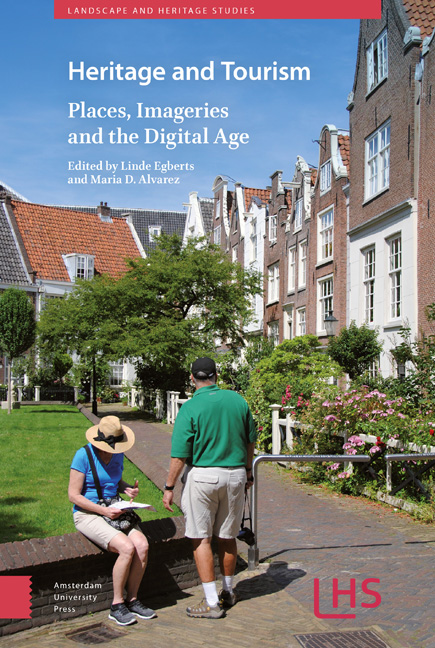Book contents
- Frontmatter
- Dedication
- Contents
- List of Figures and Tables
- Foreword
- 1 Tourism and Heritage: Crafting Experiences Through Innovation
- 2 Tourism Conflicts and Conflict Tourism: Curating “Holoscapes” in Europe’s Age of Crisis
- 3 Heritage Landscapes of Hiroshima and Nagasaki
- 4 Revealing and Presenting the Past(s) for the Public: Fethiye Mosque and Museum as a Cultural Heritage Site in Istanbul
- 5 Who Takes the Lead in Initiating Cooperation in a Cultural Network and Why?: The case study of a Rural Finnish Destination
- 6 Sustainability of Heritage-Tourism Destinations: A Demand-Based Perspective on Cusco, Peru
- 7 Localising National Tourism Websites: The case of World Heritage sites
- 8 Enhancing the Tourist Heritage Experience through “In-Situ”, Customisable, 3D-Printed Souvenirs
- 9 Tracking the Heritage Tourist: Heritage tourism and Visiting Patterns in a Historic City
- 10 The Construction of a Tourist-Historic Icon: The case of the Palace of Westminster, London
- 11 Conclusion
- Index
7 - Localising National Tourism Websites: The case of World Heritage sites
Published online by Cambridge University Press: 22 December 2020
- Frontmatter
- Dedication
- Contents
- List of Figures and Tables
- Foreword
- 1 Tourism and Heritage: Crafting Experiences Through Innovation
- 2 Tourism Conflicts and Conflict Tourism: Curating “Holoscapes” in Europe’s Age of Crisis
- 3 Heritage Landscapes of Hiroshima and Nagasaki
- 4 Revealing and Presenting the Past(s) for the Public: Fethiye Mosque and Museum as a Cultural Heritage Site in Istanbul
- 5 Who Takes the Lead in Initiating Cooperation in a Cultural Network and Why?: The case study of a Rural Finnish Destination
- 6 Sustainability of Heritage-Tourism Destinations: A Demand-Based Perspective on Cusco, Peru
- 7 Localising National Tourism Websites: The case of World Heritage sites
- 8 Enhancing the Tourist Heritage Experience through “In-Situ”, Customisable, 3D-Printed Souvenirs
- 9 Tracking the Heritage Tourist: Heritage tourism and Visiting Patterns in a Historic City
- 10 The Construction of a Tourist-Historic Icon: The case of the Palace of Westminster, London
- 11 Conclusion
- Index
Summary
Abstract
The internationalisation of tourism, supported by Information and Communication Technologies (ICTs), has asked for the “localisation” of destinations’ websites to meet information and accessibility needs of new inbound markets. The process of localisation describes the cultural adaptation of textual contents, videos, and images to meet the cultural needs and preferences of the reference audience, contributing this way to the elaboration of more effective communication strategies. Despite the importance of the web for promoting heritage sites and sustainable tourism behaviours, there is little research regarding the topic of localisation related to heritage destinations. The present article pursues both a methodological and a theoretical goal. First, it proposes a systematic method to examine cultural values online, when it comes to the promotion of UNESCO World Heritage sites (WHSs). Second, it argues about the relevance of the cultural dimensions elaborated by Hofstede and Hall for the case of heritage-tourism destinations. This exploratory study analysed how three National Tourism Organizations’ (NTOs) websites localised contents related to UNESCO WHSs for the US-American and Italian publics. Patterns of potential visitors were created to simulate credible uses of websites, which were examined on the base of a framework for analysis of cultural values (elaborated by Tigre Moura et al., 2014) and using the technique of user scenarios.
Keywords: cultural values, eTourism, ICT, localisation, National Tourism Organizations, UNESCO World Heritage sites
Introduction
The internationalisation of tourism and the extensive number of prospective travellers browsing the web to inform their travel decision (Law, Buhalis, & Cobanoglu, 2014) has increased the relevance of localising destination websites (Mele, De Ascaniis, & Cantoni, 2016). Localisation can be defined as a set of processes aimed at “modifying products or services to account for differences in distinct markets” (LISA, 2007, p. 11). Once transferred into online communication, in addition to translation of textual content, localisation of websites includes activities such as the adaptation of videos and graphics to meet cultural needs and preferences of specific markets (Hsieh, 2015). Different kinds of variation include modifications of time and date formats, units of measure, and symbols, which are considered as instrumental for a smoother understanding of the pieces of information provided to the online visitor (Cantoni & Tardini, 2006).
- Type
- Chapter
- Information
- Heritage and TourismPlaces, Imageries and the Digital Age, pp. 131 - 150Publisher: Amsterdam University PressPrint publication year: 2018



